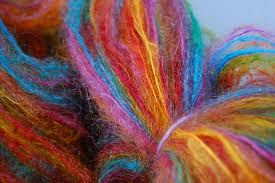
Your color options are endless, so if you are really particular about your preferred color, make sure that when you are placing a "Green"order, make sure you specify if your preference is: lime green, grassy green, forest green, sage, emerald, army, jade, pear, neon or olive. :) There are millions of different shades of every color, and I may get it wrong if you aren't specific!
Above is an Acrylic yarn which has more of a shiny luster to it. It tends to pill a lot less than other yarns which makes your item stay looking new for longer. ( Pilling is what looks like little tufts of fluff on material after it is used a lot or washed improperly) .The downside of Acrylic yarn is that some might say it is borderline "itchy".
This is a thick weight wool yarn which will keep you very warm, yet it tends to pill more than other yarns.
Above is Cotton Yarn, which is generally duller in color, although bright is available and becoming with cotton yarn. Cotton yarn is light weight and can be worn in the spring and summer because its cooler. Cotton yarn also has very little pilling effect. Cotton Yarn is harder to work with because it has a lot less stretch/give than others, it is also pretty tricky for sizing but if crocheted correctly, Cotton Yarn can be so very clean looking! BEAUTIFUL!
Above is Mohair yarn, it is very important that if there is known allergies to Mohair Goats, or Mohair rabbits, that you steer clear of this yarn. On its own, mohair has a very light, fluffy texture, so it is often spun together with other fibers to form a blend. Blends that feature mainly wool content are heavy and durable, with less of the fuzzy halo characteristic of mohair fiber. These blends are versatile and can be used for any number of items.
Above is a very thin almost string like yarn used for items such as doilies or table cloths and even some light airy sweaters.
Above is variegated yarn, which has been dyed with multicolor dye which makes it fun to use. Variegated yarn is most common in cotton and acrylic material.
Above is another example of Variegated yarn this time with and acrylic/wool mix.
Caring for your items:
Most of the yarns I use, should be hand washed and laid to dry. It is the best way to prevent excessive pilling and shrinkage. And if spot treating isn't an option, I suggest this method for any of my purchased items.












